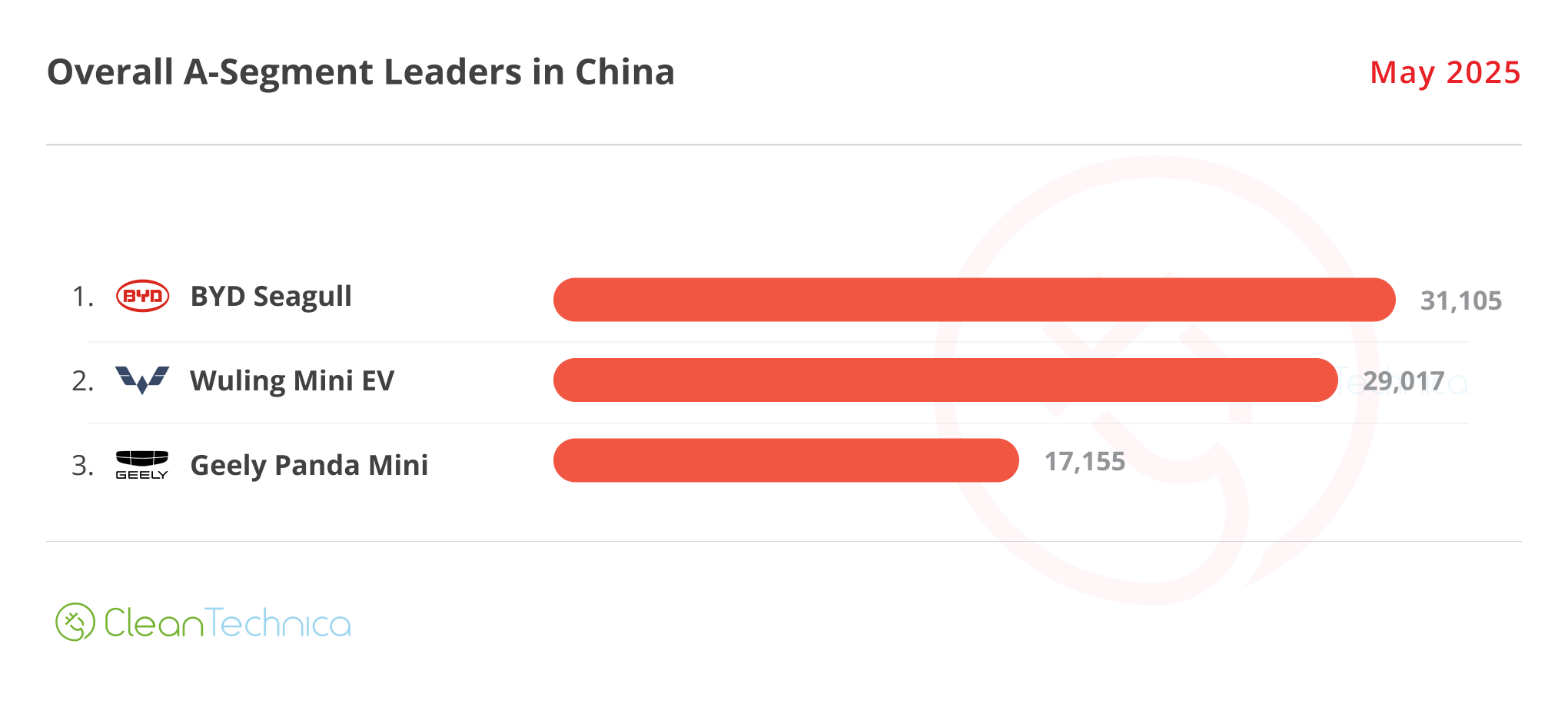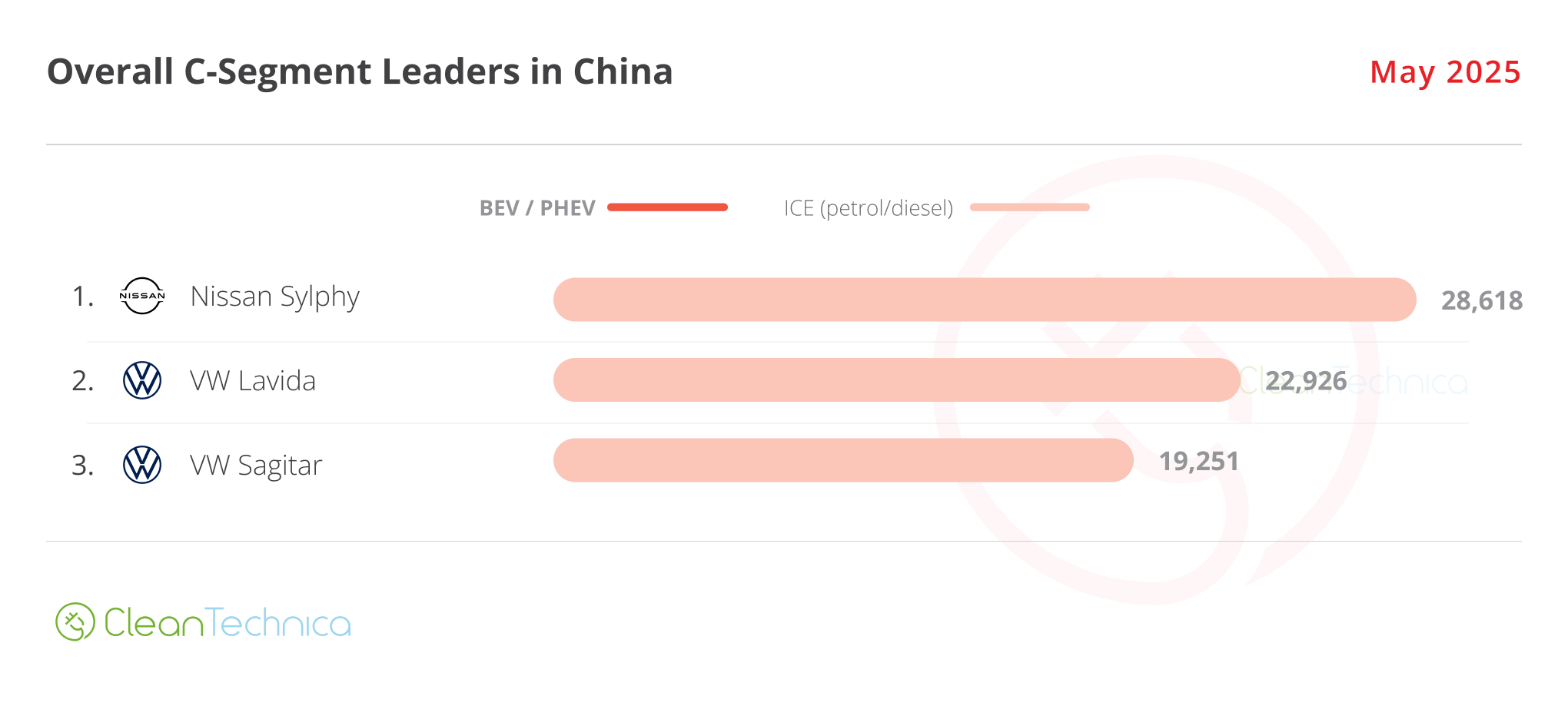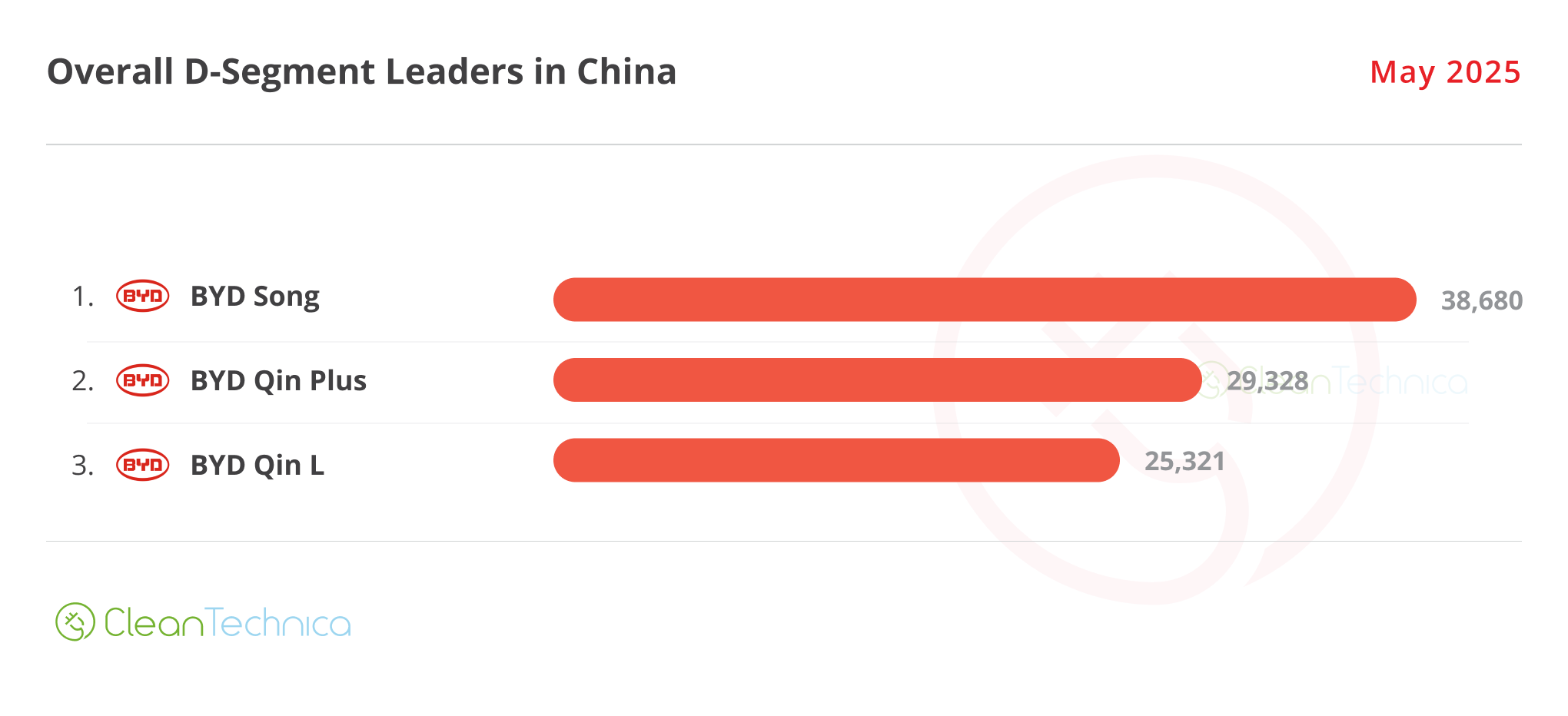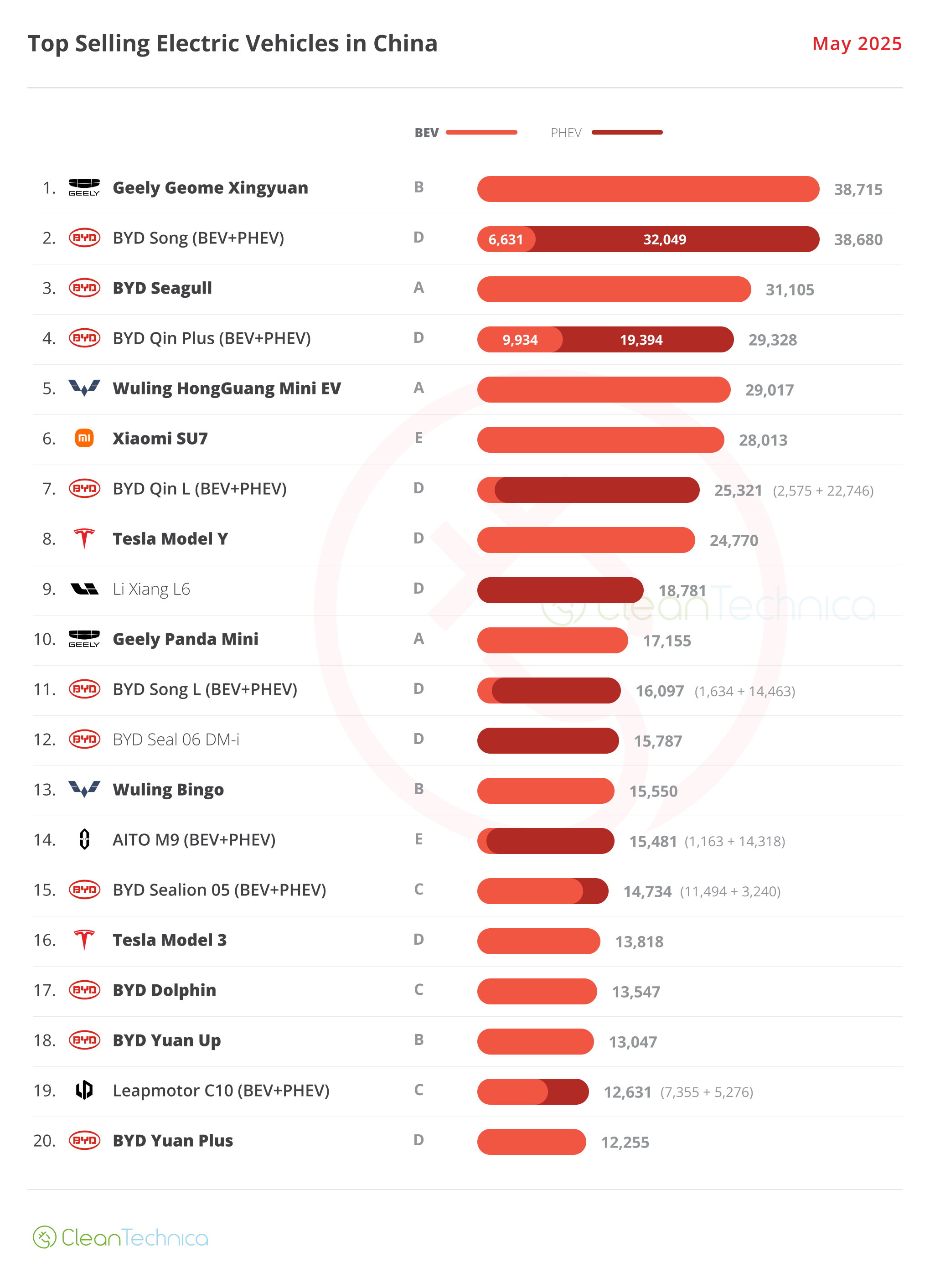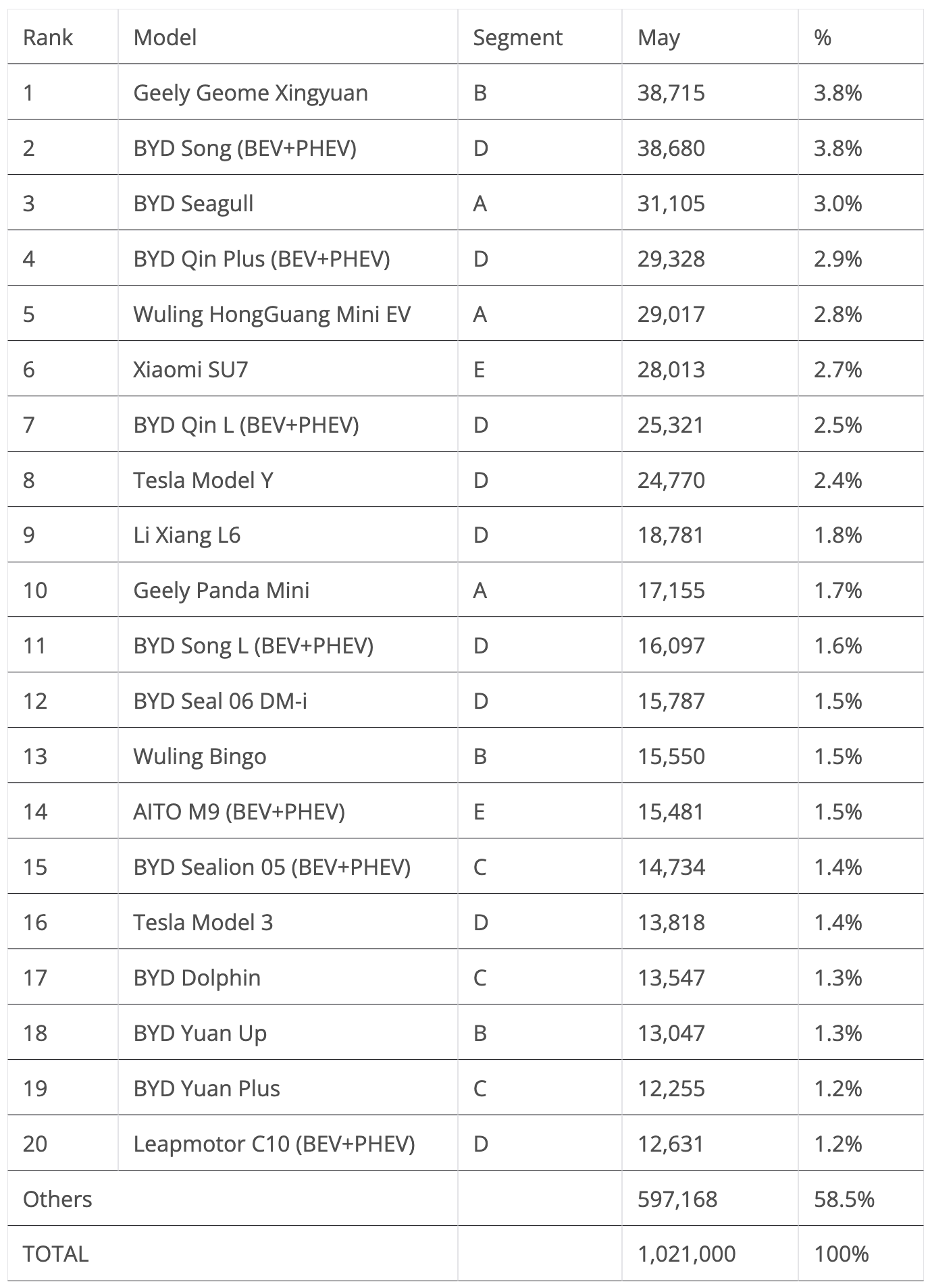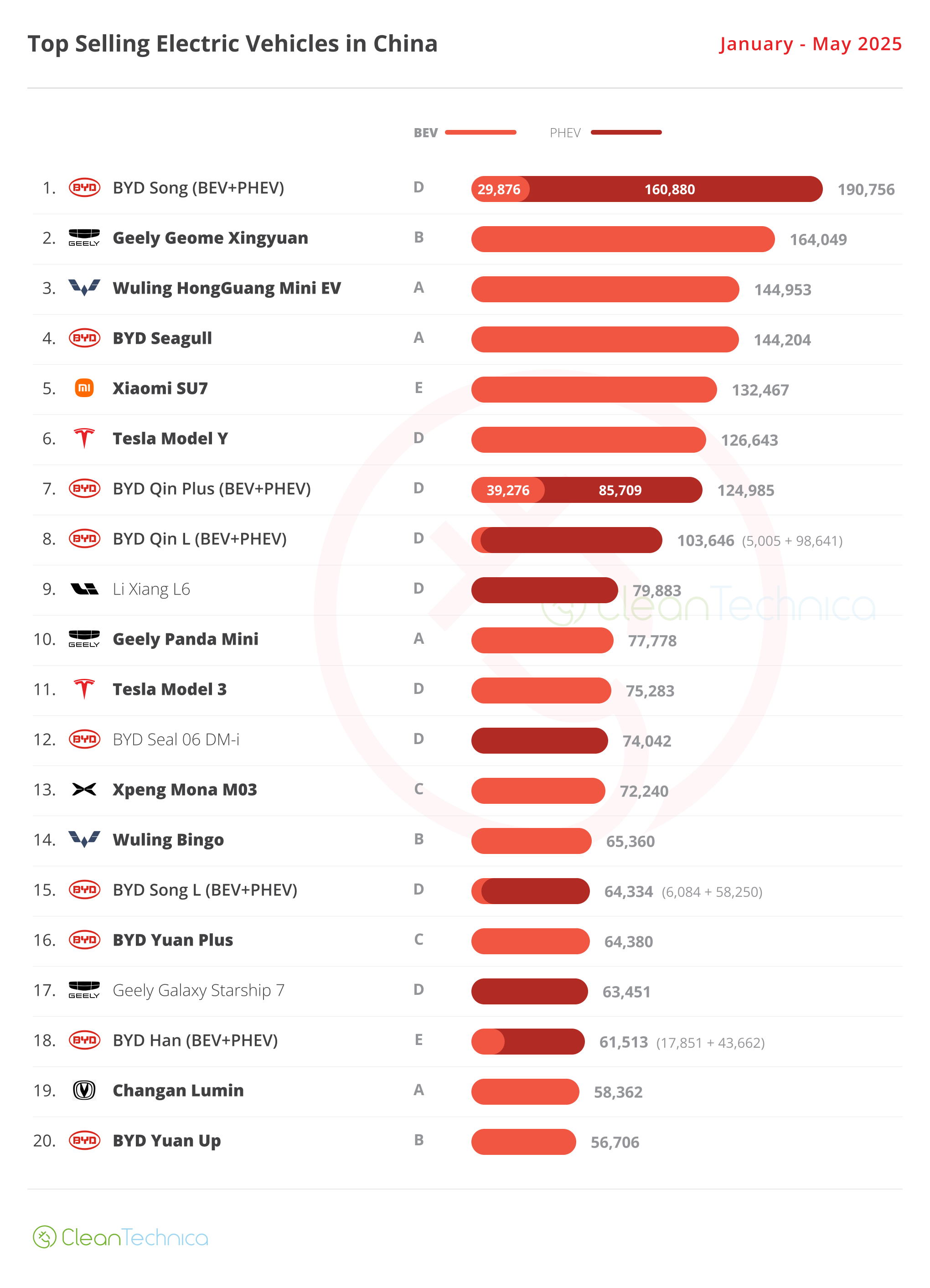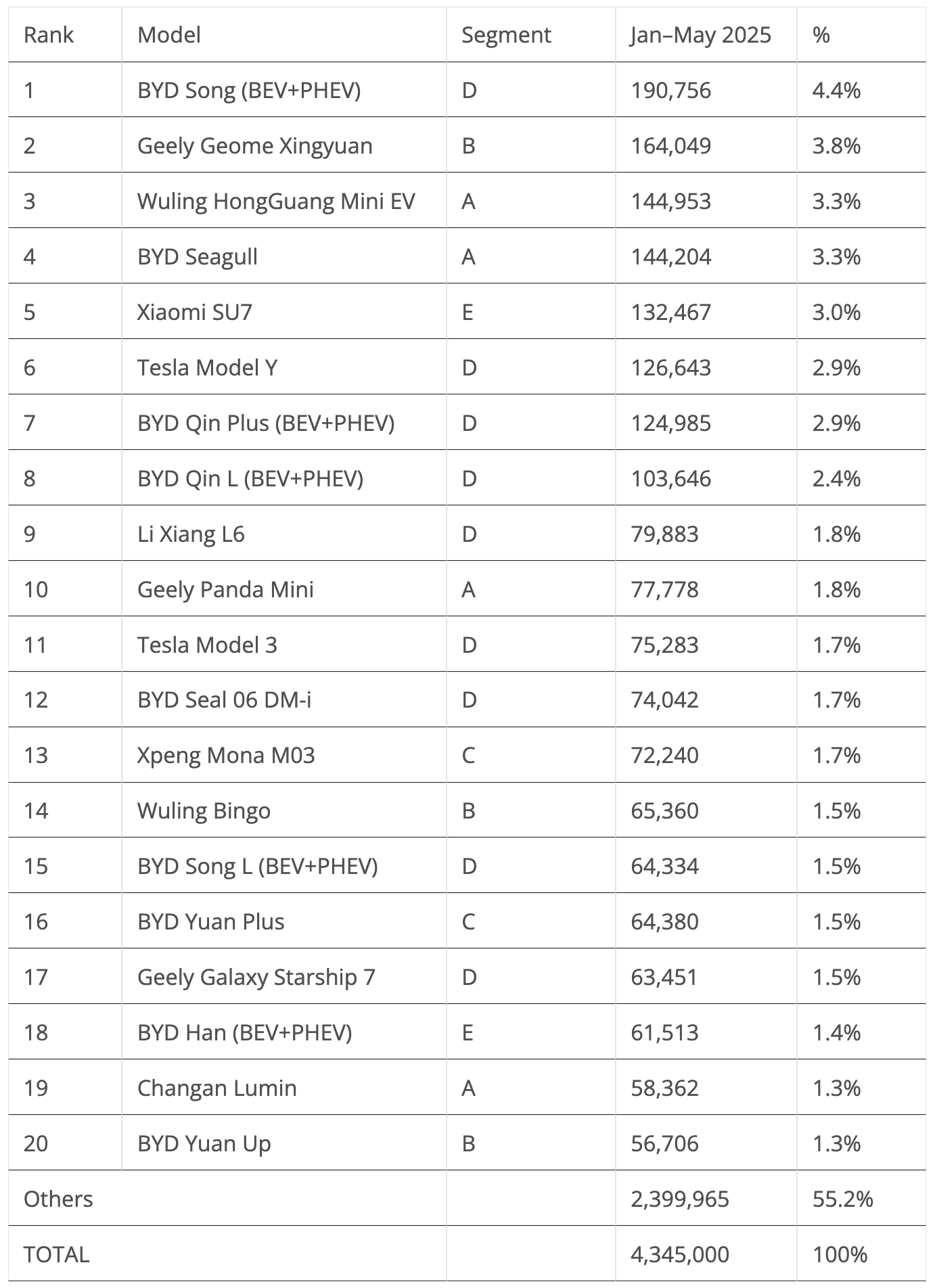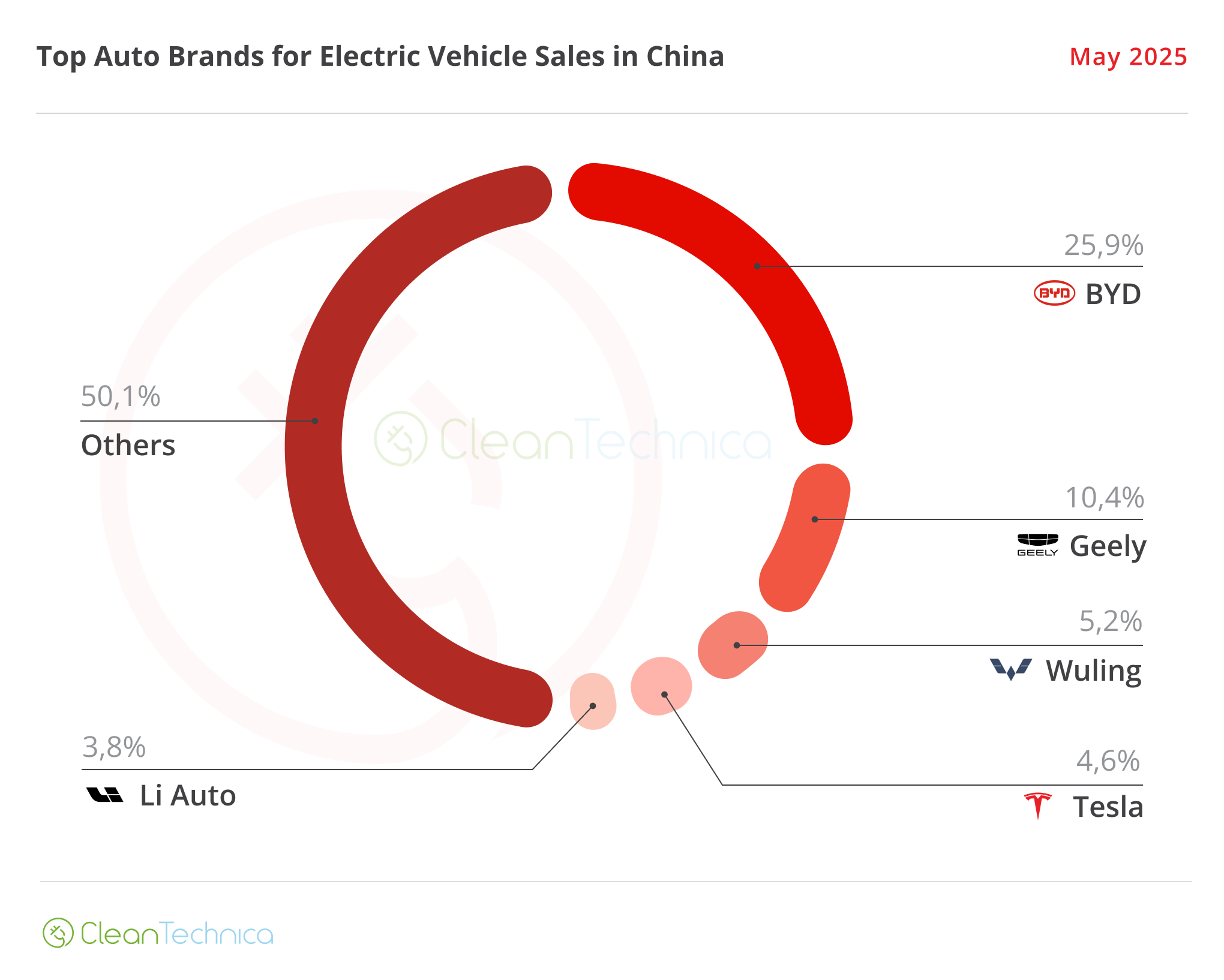53% EV Share in China! — May 2025 Sales Report

BEVs represented close to a third of the total Chinese car market in May.
May saw the continuation of the never ending growth of the Chinese EV market, with plugins scoring over a million sales in May (in a 1.9-million-unit overall market).
Digging deeper into the numbers, EREVs were the fastest growing technology, going up by 52% to 116,000 units, or 11% of plugin sales, while PHEVs grew 32% YoY (29% share of plugins) and BEVs grew 23% (59% share of plugins).
This pulls the year-to-date (YTD) tally to over 4.3 million units. So, we should see plugins end the year well above 10 million units — in China alone….
Share-wise, May saw plugin vehicles reaching 53%! Full electrics (BEVs) alone accounted for 31% of the country’s total passenger auto sales.
This good result in May pulled the 2025 share to 49%. BEVs were stable on their own, at 30%. Expect to see plugins at 50% and BEVs at around 31% by the end of June.
(Could China finish the year above 60%?)
Having a quick look at export numbers, in May there were 200,000 units, an 81% increase YoY, and, interestingly, while 53% of its domestic market was electric, when it comes to exports, the EV share was smaller, at 45%. So, it seems that China is exporting a greater proportion of stinkers, compared to EVs, than it’s selling in its domestic market.
In the overall ranking, in May, fully fossil-fueled models had just two representatives, with the best placed being the Nissan Sylphy in 6th.
When will we see a top 10 fully made of plugins? June? Or will we have to wait for the second half of the year?
Looking at the best sellers in several size categories, all but the C segment (compact cars) have plugins leading the way. In fact, the C segment saw a 100% ICE (internal combustion engine) podium, a rarity these days.
In all other categories, they were either absent or the minority. This is a recurring topic, as it seems that the C segment is the hardest of all to convert into EVs. Looking at the bright side of this, it means that models like the Xpeng Mona M03, BYD Sealion 05, and Geely Galaxy E5 have plenty of room to grow.
The biggest surprise was the 100% BYD podium in the midsize category, a feat in itself. BYD alone has 10 midsize models in its lineup.
Another topic to highlight is the domination that the Geely Xingyuan and Xiaomi SU7 are having in their respective categories, with the small hatchback and the sports sedan doubling the sales of their category runner-up models.
Here’s more info and commentary on May’s top selling electric models:
#1 — Geely Geome Xingyuan
Geely has cracked the code. The Xingyuan allowed the make to beat BYD … as well as the rest of the competition. This May, the small hatchback won its second consecutive best seller trophy in China. Besides the killer price, all the support that comes from a leading OEM like Geely doesn’t hurt, as well as a rounded, sensible design — somewhere between a Wuling Bingo and a Smart #3. Starting with an 80,000 CNY (+/-$11,000) price, the buyer gets a 30 kWh LFP battery from CATL, which is nothing to write home about until you realise that its price places it closer to the BYD Seagull (70,000 CNY for the 30 kWh version) than the BYD Dolphin (100,000 CNY). In May, the Geely model hit 38,715 registrations, its fifth record score in a row. Exports? Surely that is in the cards. But first Geely will need to finish the production ramp-up in order to satisfy its own internal market.
#2 — BYD Song (BEV+PHEV)
BYD’s midsize SUV lost its best seller status again, scoring 38,680 registrations, a steep 30% drop YoY. It seems the veteran model (six years is an eternity in China) is close to its expiration date in its domestic automotive market, so while the 2025 Best Seller title is still a strong possibility, 2026 should see it pass the septre to a different model. A competitive price can only get you so far, and with an increasingly competitive market, BYD’s midsize SUV will need a significant improvement if it wants to continue clocking 40,000+ sales/month, a necessary threshold to continue leading the cutthroat Chinese auto market.
#3 — BYD Seagull
The small EV secured another podium presence thanks to 31,105 registrations, a 7% drop YoY. With part of production now being diverted to export markets, it seems demand for the little Lambo is now at cruising speed in China. The perky EV is now podium friendly. Even with its attention now diverted to other geographies, like Latin America, Asia-Pacific, and Europe, expect the little BYD to continue being part of the BYD pack that populates the Chinese top 10.
#4 — BYD Qin Plus (BEV+PHEV)
The old dog joined the top 5 in April, thanks to 29,328 registrations last month, a steep 40% drop YoY. Still, that volume meant that it was the best selling sedan in China, all powertrains counted. The 7-year-old body might be showing some wrinkles, but the low prices still allow significant demand for the midsize sedan. Question is — for how long?
#5 — Wuling Mini EV
The 2021 best selling EV in China is back in form, thanks to a refresh, and above all, a new 5-door version. This allowed the small city car to reach 29,017 registrations in May, a 77% increase YoY. So, it seems the tiny EV is back to its good old days. With the price of the 5-door version starting at 45,000 CNY ($6,200), it continues to be one of the cheapest in its category. And this time it’s not too bare bones, as it has a 16 kWh LFP battery, supports DC charging, and includes stuff like air conditioning and remote control via mobile phone.
Looking at the rest of the best seller table, the highlights come from the second half of the table, with the AITO M9 jumping to #14 while the BYD Sealion 05 is benefitting from the production ramp-up of its BEV variant to reach the 15th position.
At the bottom, we have the Leapmotor C10, which joined the table for the first time at #20, highlighting the strong moment that the value for money startup is experiencing.
Outside the top 20, we had a few recent models ramping up production.
Starting with the BYD stable, the Tang L collected a strong 7,004 registrations, the Seal 05 had 7,631 registrations, while the more upmarket Fangchengbao Tai 3 compact SUV had 5,598 registrations in May.
Elsewhere, we should highlight the ramp-up of the Avatr 06 midsize sedan, scoring a significant 6,368 registrations. This could be a good sign for Changan’s premium brand, which has been struggling to find success with its earlier models. Still discussing Changan’s stable, more precisely the Qiyuan lineup, the new Q07 midsize SUV had 8,081 registrations in only its second month on the market.
As for the Geely stable, there are also a couple of models in ramp-up mode. The Geely Starshine 8 flagship sedan delivered 10,187 units in its first full month on the market. It seems Geely’s new model could be top 20 material. The other EV ramping up from Geely Holding is the Lynk & Co 900, which reached 5,593 registrations.
Finally, a couple of mentions go to the new AITO M8, a less glitzy version of the M9 full size SUV, which reached 12,116 registrations in only its second month on the market. Will we see two AITO models on the table soon?
Incidentally, the same could happen to Leapmotor, because not only has the C10 joined the table in May, but the new B10 compact crossover is ramping up, reaching 10,105 units. So, we might see two Leapmotor models on the best seller table.
The 20 Best Selling Electric Vehicles in China — January–May 2024
Looking at the 2025 ranking, the main highlights were the Li L6 and Geely Panda Mini jumping two positions, to 9th and 10th, respectively. The two models benefitted from slow sales of the Tesla Model 3 and Xpeng Mona M03 to move up the ranking.
Further below, the #14 Wuling Bingo and #15 BYD Song L jumped three positions each. We should also have a close look at how the Song L behaves, as the midsize SUV is effectively the 2nd-generation Song. It has some big shoes to fill, considering all the trophies gathered by the first generation.
Now, let’s have a look at the top selling EV brands and auto groups.
Auto Brands Selling the Most Electric Vehicles in China
Looking at the auto brand ranking for plugin vehicles, there isn’t much news. BYD (25.9%, down from 26.2%) remains as stable in its leadership position as ever.
Despite losing share, it is the same story with Geely (10.4%, down 0.1% in May), with the brand standing firm in the runner-up position.
Things get more interesting below, though. Wuling (5.2%, down from 5.4% in May) stayed in the 3rd spot, gaining some distance over Tesla, which lost even more share (4.6% now vs. 4.9% in May).
In a normal timeline, this would mean that in June, Tesla would surely surpass Wuling, but because we are in an alternative timeline, Tesla’s task is now harder. So, I wouldn’t be surprised if, for the first time since 2019, Tesla couldn’t reach the podium of the Chinese EV manufacturer table by the end of the year.
Elsewhere, #5 Li Auto (3.8%) gained some ground over the two above it, all while Xpeng (3.4%, down 0.1%) lost a position to Leapmotor (3.6% now, up from 3.3% in April), with this startup now threatening #5 Li Auto. So, June might bring a new frontrunner in the Chinese startup race.
Auto Groups Selling the Most Electric Vehicles in China
Looking at OEMs/automotive groups/alliances, BYD is comfortably leading, with 28.9% share of the market, benefitting from positive performances from Denza and Fangchengbao, while Geely is a distant runner-up with 13.1% share.
Far from runner-up Geely, there was a position change in the 3rd spot. Changan (6.7%, up 0.2%) benefitted from good performances from its daughter brands Avatr and Qiyuan, all while SAIC continued dropping (6.1%, down 0.2%).
Tesla (4.6%) remained in 5th, but Tesla’s 2024 3rd spot in the OEM ranking seems almost impossible to achieve, and it could even be the case that there will be no Tesla in this top 5 at the end of the year, as #6 Chery (4.4%) could surpass it in the coming months.

Sign up for CleanTechnica's Weekly Substack for Zach and Scott's in-depth analyses and high level summaries, sign up for our daily newsletter, and follow us on Google News!
Whether you have solar power or not, please complete our latest solar power survey.
Have a tip for CleanTechnica? Want to advertise? Want to suggest a guest for our CleanTech Talk podcast? Contact us here.
Sign up for our daily newsletter for 15 new cleantech stories a day. Or sign up for our weekly one on top stories of the week if daily is too frequent.
CleanTechnica uses affiliate links. See our policy here.
CleanTechnica's Comment Policy



